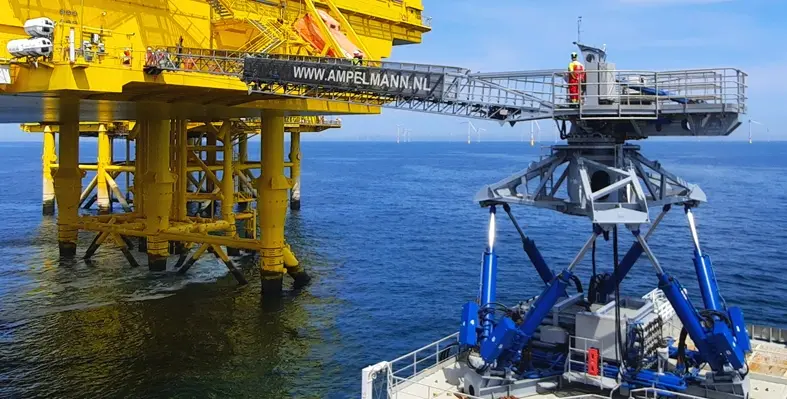Ship to Ship operations (S2S) have been a cornerstone of offshore logistics for years, providing a critical link in the transfer of personnel and cargo between floating vessels and structures
As the offshore energy sector expands into deeper waters, where constructing fixed structures is prohibitively expensive, the demand for safe and efficient access from one floating structure to another has surged.
Despite the technical complexity involved in transferring personnel and cargo between two floating objects, Ampelmann’s innovative motion compensated gangways have long been capable of facilitating S2S operations. Until recently these systems have successfully enabled operations on a variety of different floating structures, including floating wind turbines and other vessels, but not yet on Single Point Buoy Moorings (SPMs).
An important component of the modern oil and gas sector, SPM’s, often paired with FPSO’s, enable the quick on- and offloading of crude oil or gas. Traditional access methods, such as “bump and jump” – where a vessel pushes against the structure to allow personnel to jump across – or towing the SPM back to port for repairs, have been the primary methods of access during maintenance operations. While these methods have been effective, they come with obvious safety and efficiency concerns.
UAE pilot project
Earlier this year, Ampelmann’s electric L-type gangway was used on a pilot project for a maintenance campaign on an SPM offshore Abu Dhabi, UAE. As these floating structures can exhibit extreme motions relative to the vessel, they present additional challenges for Walk to Work (W2W) systems. A custom-designed landing platform was built and attached to the SPM to ensure a safe and stable gangway connection and with the help of in-depth workability studies and through years of experience with similar operational procedures, the project was completed within 12 days.
The successful completion of the project marks a turning point in the servicing of these structures and shows that Ampelmann’s gangways have the capacity to compensate for the complex and divergent motions of both the vessel and the SPM, ensuring safe and efficient personnel and cargo transfers.
As the offshore energy sector fixes its gaze beyond the horizon, further out from shore, where fixed offshore structures are no longer desirable, the S2S capabilities of W2W systems such as Ampelmann’s are poised to become increasingly relevant. From operations between two vessels to FPSOs, semi-submersibles, floating wind turbines, and now SPMs, Ampelmann’s portfolio of gangways is ready for operations on any type of floating structure.
Marine access to single point buoy moorings

Ampelmann’s portfolio of gangways is ready for operations on any type of floating structure. (Image source: Ampelmann)








